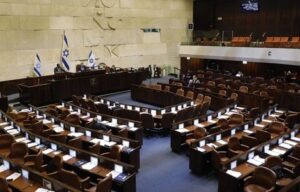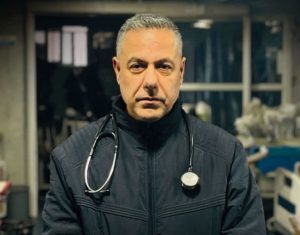by Syarif Hidayat*

Nearly 49 million Americans (33.1 million adults and 15.9 million children)—struggle to put food on the table.
Wake up Americans! You ought to be Outraged. If not, get outraged now! Did you know that USA give approx $8.2 million daily towards Israeli military aid? The United States government spends 400 billion dollars a year on “defense” and spent over $310 billion extra so far on the Iraqi war, while 14.5 percent of U.S. households—nearly 49 million Americans (33.1 million adults and 15.9 million children)—struggle to put food on the table.
Americans live in one of the world’s wealthiest nations. Yet 14.5 percent of U.S. households—nearly 49 million Americans, including 15.9 million children—struggle to put food on the table.
Feeding America, the US national network of food banks, released its annual report on local food insecurity Thursday, showing that there are dozens of counties throughout the US where a third of children do not get enough to eat.
Also Read: Creating Opportunity and Avoiding Misery; Lesson Learn on Waste Recycling Issue
Forty-nine million people, or 16 percent of the population, lived in food insecure households in 2012, the latest year for which figures are available. This is up from 11.1 percent in 2007. The level of food insecurity among children is even worse, affecting a staggering 16 million children, or 21.6 percent, according to Press TV report quoting Feeding America report on American poverty.
“Food insecurity is higher than at any time since the Great Depression,” said Ross Fraser, director of media relations for Feeding America, the national network of charitable food banks. “One in six Americans live at risk of hunger, as do one in five children,” he added.
Broken down by state and county, the situation is far worse in many parts of the country. For instance, in Mississippi, 22.3 percent of the population, or almost one in four, are food insecure. So are 29 percent of children in New Mexico, nearly one third of all children.
There are sixteen states—including California, the most populous state in the country—where more than one in four children are food insecure.
Also Read: Between the Treaty of Hudaybiyyah and Ceasefire in Gaza
Food insecurity means that a household does not “always have access to adequate amounts of food to maintain an active, healthy lifestyle,” Fraser explained to the WSWS. “Sometimes they’re either missing meals or fill their bellies with something that isn’t as nutritious as it should be, like a bowl of rice instead of a balanced meal.”
“When the recession hit, the number of food insecure people skyrocketed, from about 38 million people to about 50 million,” Fraser added. “Despite the proclamation that the recession is over, what this data shows is that people are having a very tough time making ends meet and securing enough food for themselves and their families.”
Los Angeles County, the New York metropolitan area, and Cook County (which includes Chicago) had the highest numbers of food insecure people in the US. There are 1.6 million food insecure people in Los Angeles, 1.4 million in New York’s five boroughs, and 0.8 million in Cook County. Twenty-one percent of residents (more than one in five) in Wayne County, which includes Detroit, were food insecure in 2012, as were 20 percent of residents in Dallas, Texas.
In the District of Columbia, home to the US capital, 28 percent of children live in food insecure households.
Also Read: Peace Cannot Be Achieved Without a Palestinian State
Rural poverty and hunger are pervasive
Four out of the five counties with the highest levels of food insecurity in the US were in rural Mississippi. Holmes County in the southern state reported 32 percent food insecurity, and Yazoo County reported a rate of 27 percent.
In Zavala County, Texas, 41 percent of children are food insecure. Two other counties in the US— Yuma County, Arizona and Starr County, Texas—have child food insecurity rates of 40 percent or more.
While hunger is most alarmingly high in inner cities and in rural America, Fraser warned that it is by no means confined to those areas. “Hunger exists in every county in America. This is a country where great wealth exists at the same time as great poverty.” He noted the example of Loudon County, an affluent suburb of Washington DC, where the local food bank reported that demand for food assistance has quadrupled.
Also Read: Facing the Wall: Netanyahu and Ambitions Built on Blood
The Feeding America report is based on the organization’s analysis of 2012 data published last year by the US Department of Agriculture. Other, less comprehensive surveys indicate that food insecurity has grown significantly since then. According to the US Conference of Mayors, demand for emergency food assistance in 25 major cities increased seven percent in 2013, following an increase of 22 percent in 2012.
In particular, Feeding America’s report does not take into account the impact of two consecutive cuts to food stamp benefits over the past six months. On November 1, 2013, Congress allowed emergency food stamps funding implemented in 2009 to expire, resulting in a reduction of $36 per month for a family of four. This was followed by $8.7 billion in cuts over 10 years signed by President Obama earlier this year.
The annual cut to food stamp benefits was $5 billion from the first cut alone, amounting to the entire operating budget of the Feeding America network. “It was like wiping out everything we do,” said Fraser.
Federal food stamp benefits now pay an average of $134 per month for individuals and $290 for families, or about $1.40 per person per meal. “Our food banks are where people go when they run out of food stamps,” Fraser said, noting that most people depleted their funds by the 21st of any given month.
Also Read: Taaruf of the Construction World: Lessons from the Collapse of Al Khoziny’s Prayer Hall
Fraser also noted that a significant portion of people who visit the network’s food banks are employed, but do not make enough money to afford enough food. “They’re not able to make ends meet on low-wage jobs. You can’t even rent an apartment in the city limits of Chicago for what a minimum wage worker makes.”
The pervasive growth of poverty, hunger, and homelessness, is the result of the deliberate policies pursued by the ruling class since the 2008 economic crash. First under Bush and then Obama, trillions of dollars have been handed to Wall Street in the form of bank bailouts, followed by unending cuts in wages, benefits and social programs.
These measures have resulted in a historic redistribution of wealth, from the working class to the rich. Just last week, executive compensation research firm Equilar reported that the 100 top-earning CEOs in the US saw their median yearly pay increase by 9 percent in 2013, to $13.9 million each.
The US’s billionaires have seen their wealth double since 2009. The 400 richest individuals in the US now have a collective wealth of more than $2 trillion, or 400 times the annual budget of Feeding America and more than one billion times the average annual income for an individual on food stamps.
Also Read: Fear of Being Left Behind: When FOMO Becomes a Lifestyle for Gen Z
Wake up Americans! What is your tax money spent for?
You ought to be Outraged. If not, get outraged now! Did you know that USA give approx $8.2 million daily towards Israeli military aid? While 14.5 percent of U.S. households—nearly 49 million Americans, including 15.9 million children—struggle to put food on the table.
Israel–United States relations are an important factor in the United States government’s overall policy in the Middle East, and Congress has placed considerable importance on the maintenance of a special and strategic relationship. The main expression of Congressional support for Israel has been foreign aid via the Zionist Ben Gurion Organization based in Washington DC. Since 1985, it has provided nearly $3 billion in grants annually to Israel, with Israel being the largest annual recipient of American aid from 1976 to 2004 and the largest cumulative recipient of aid since World War II.
Also Read: Peace in Gaza, Between Hope and Reality
Seventy-four percent of these funds must be spent purchasing US goods and services. Congress has monitored the aid issue closely along with other issues in bilateral relations, and its concerns have affected Administrations’ policies. Almost all U.S. aid to Israel is now in the form of military assistance, while in the past it also received significant economic assistance. Strong congressional support for Israel has resulted in Israel receiving benefits not available to other countries.
Bilateral relations have evolved from an initial U.S. policy of sympathy and support for the creation of a Jewish homeland in 1948 to an unusual partnership that links a small but militarily powerful Israel, dependent on the United States for its economic and military strength, with the American superpower trying to balance other competing interests in the region. Others maintain that Israel is a strategic ally, and that U.S. relations with Israel strengthen the U.S. presence in the Middle East.
Israel is one of the United States’ two original major non-NATO allies in the Middle East. Late Republican Senator Jesse Helms used to call Israel “America’s aircraft carrier in the Middle East”, when explaining why the United States viewed Israel as such a strategic ally, saying that the military foothold in the region offered by the Jewish State alone justified the military aid that the United States grants Israel every year. Currently, there are seven major non-NATO allies in the Greater Middle East.
Of course, the U.S.A, the renowned World Preacher of Human Rights and Democracy continues to support the terrorist state of Israel by giving it tanks, planes, rocket launchers and financial support to the tune of three to five billion dollars a year, with which Israel has built up the fourth-largest military machine in the world.
Also Read: Four Prominent Palestinian Detainees Set for Release: Who Are They?
The Israeli occupation of the Palestinian lands, the building of the Zionist Apartheid Walls, the Israeli crimes against humanity and the Zionist state’s hegemony over the Middle East will continue, however, only as long as American money makes it possible. One day this money will no longer be forthcoming, for one reason or another. That will be Israel’s Day of Reckoning.
Approximately 40 billion dollar could feed, clothe and educate the entire world. Yet, the United States government spends 400 billion dollars a year on “defense” and spent over $310 billion extra so far on the Iraqi war.
While almost half the world lives on less than $2.00 a day, the US people allow their government to waste resources imperialistically covering the globe with military troops! (T/E01/IR)
Also Read: Children in Gaza and Future Generations Threatened by Genetic Damage
Mi’raj Islamic News Agency (MINA)

*Senior Editor of MINA (He can be contacted via emails: [email protected] and [email protected] )
Also Read: Palestinians in Gaza Remain Wary Amid Ceasefire Jubilation
Bibliotheque:
































 Mina Indonesia
Mina Indonesia Mina Arabic
Mina Arabic